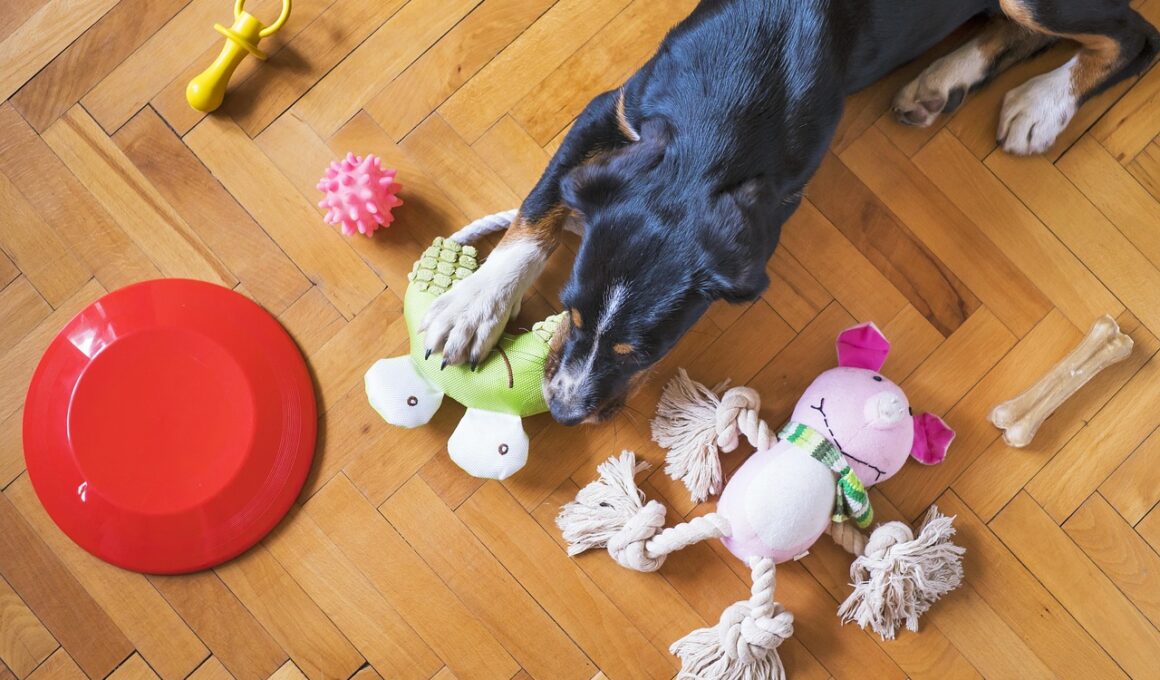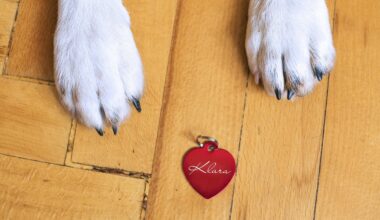Household Items That May Trigger Destructive Chewing
Destructive chewing can be a major problem for dog owners. It’s important to identify household items that may trigger this behavior. One common item is shoes. Dogs may chew on shoes due to the scent of their owners. This scent can be comforting to them. Another item includes furniture. Dogs may chew on wooden furniture out of boredom or anxiety. This can be particularly problematic with certain breeds known for their chewing tendencies. Additionally, cables and cords can be a danger. Chewing on electrical cords may cause severe injuries or even electrocution. It’s crucial to dog-proof these areas. Toys are also important. Providing appropriate chew toys can redirect their chewing behavior. Look for durable options designed for heavy chewers. Lastly, consider items like remote controls or books, which can attract curious dogs. They may want to explore and play, leading to unwanted chewing. Understanding triggers is the first step in addressing this issue effectively. Owners should strive for a chew-friendly environment while redirecting attention towards appropriate items.
Another area to consider is the kitchen. Dogs are often attracted to food items and related containers. Chewing on containers can be especially common if they smell food residue. Tupperware and plastic bags may become appealing targets. Chewing on these items not only destroys the containers but may also pose choking hazards. Food leftovers can also entice chewing behavior. Dogs are known for their scavenging instincts, so be vigilant with leftover food on counters. Trash cans can also be a significant risk for destructive chewing. Many dogs enjoy rummaging through trash cans, resulting in significant messes. In addition to food items, consider household cleaning products. Many cleaning supplies have strong scents that may intrigue your dog. While they may not be chewing these, they can pose serious health risks if ingested. Keep all cleaning items stored securely out of reach. Regularly check your home for chew-worn furniture and items. Maintaining a dog-friendly space may require ongoing adjustments and vigilance. It is necessary to provide an engaging environment with safe alternatives to discourage destructive chewing.
Another significant area to examine is the living room, where pets often spend most of their time. Here, items such as couch cushions and pillows may attract dogs looking for comfort. They may see these items as perfect targets for chewing due to their soft textures. Chewing these may not only damage the cushions but also lead to ingestion of materials that can harm them. Decorative items also pose risks; dogs may view these objects as chew toys or play objects. This includes knick-knacks and even picture frames that are within their reach. Additionally, rugs can be a target for destructive chewing. Many dogs love to dig or chew on the textures of rugs, leading to damaged flooring. It’s essential to regularly reevaluate the items in your living room. Create a safe area with dog-friendly toys and designated spaces to encourage appropriate chewing behavior. Educational training can also help owners manage and redirect these behaviors effectively. Stratifying different sections and keeping attractive items off limits can lessen destructive tendencies. Owners need to be vigilant with their furniture arrangements to ensure their pets are safe and happy.
In addition to the living room, the bathroom is another room where dogs may find items suitable for destructive chewing. Items such as towels can be inviting with their textures and scents. They often smell like their owners, making them appealing to chew on. Additionally, bathroom rugs may cause problems, as many dogs enjoy digging into soft surfaces. Furthermore, products like toilet paper can attract curious dogs due to their interesting texture and ability to unroll easily. This may lead to messes throughout the house, causing frustration. You must also note items like shampoo bottles, as some scents can intrigue dogs and prompt chewing behavior. Items that could easily be knocked over and chewed should be kept out of reach. Keep the bathroom clean and free from tempting chewable items. Consider providing alternatives such as durable chew toys in an area nearby to distract them from household items. It’s crucial to ensure dogs feel secure and happy without resorting to chewable options that cause household damage. Regular hygiene checks can help in maintaining a dog-friendly environment.
Managing Chewing Behavior
Your garage is another space where destructive chewing can occur, often overlooked by dog owners. There, many items may spark curiosity, leading to unwanted chewing behavior. Tools and outdoor equipment can present dangers during play. Dogs may find them fascinating but can also suffer injuries from sharp edges and parts. Additionally, chemical products are often stored in garages; even slight exposure can lead dogs to chew on poisonous items, which is extremely dangerous. Remember to secure your power tools and keep lawns and garden supplies out of reach. Repurpose your space to be more dog-friendly by using storage containers for hazardous items. You can reduce accessibility to harmful items while still providing room for exploration. This way, your garage can be part of a safe environment. Don’t hesitate to create barriers if necessary. Additionally, ensuring fun outdoor activities can redirect their attention away from potential chew hazards. A proper ratio of exercise, mental stimulation, and safe play areas can make a significant difference. Addressing priorities within these ample spaces helps create a safer experience for your dogs.
In the bedroom, the presence of personal items can trigger chewing behavior in many dogs. Belongings like socks and underwear are often within reach and smell like their owners, making them particularly appealing targets. Dogs can view these items as toys, leading to destructive chewing behavior. They might not even mean to cause trouble; their instincts often drive such actions. Additionally, items such as charging cables or phone chargers may tempt curiosity due to their texture and movement. Preventing chewing on these is crucial as they pose serious risks if chewed through. Establish designated areas in the bedroom where appealing items can be stored. Use baskets or containers to keep personal items out of reach. Training your dog to understand boundaries regarding household belongings is vital. With adequate training and rewards for positive behavior, you can discourage unwanted chewing. Incorporating engaging toys can also help shift their focus away from personal items. Making proactive measures creates a more dog-friendly environment without compromising your living space. Make changes to maintain peace between your belongings and your pets.
Finally, consider the outdoor area, which poses risks to household items and can encourage chewing behaviors. Many dogs find garden hoses very tempting as they often move and make noise, which stimulates their instincts. Chewing on hoses can lead to cuts and choking hazards. Additionally, any garden tools or accessories left unattended can be dangerous. Tools such as shovels or rakes should be stored away when not in use. It’s crucial to maintain a tidy outdoor space while ensuring your pet’s safe interaction. Certain plants can also pose serious risks; plants like lilies or azaleas are toxic if ingested. You can create a designated dog-friendly zone in the yard to prevent unwanted chewing behavior. Planting safe dog-friendly plants encourages gardening while protecting your pet. Keeping a close eye during outdoor play is equally necessary to discourage unwanted chewing. Blocks or small barriers can redirect dogs away from certain areas or items. Your yard can become a comforting space for pets, allowing them the freedom to run while safeguarding against potential hazards. Balancing exploration and safety in the outdoor environment is essential.


